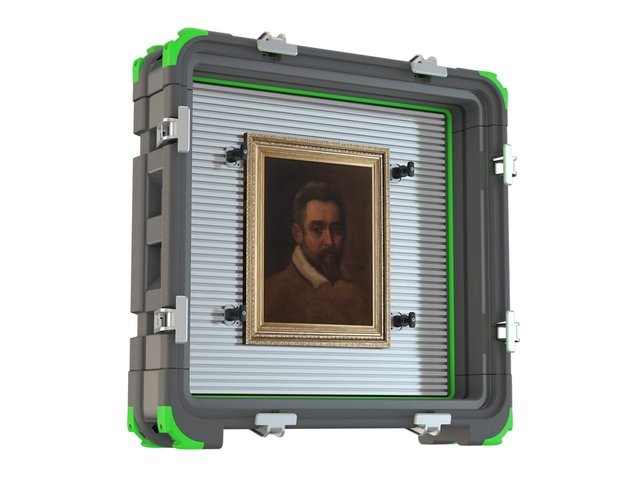Now that the autumn art fair season is well and truly upon us, it seems an appropriate moment to flag up one of the more overlooked elements of the proceedings: namely the containers and wrappings required to swathe all the myriad artworks that are shown and then sold. Packaging may not be the most glamorous aspect of an art fair but it is certainly one of its most essential and also undoubtedly one of its most environmentally problematic, with every fair generating a mountain of waste in its wake, which then invariably ends up in landfill or worse still, our oceans.
Not only are the majority of artworks contained and protected by single use materials that are made from plastics derived from fossil fuels—bubble wrap being one of the most conspicuous examples—but these materials are then invariably discarded after a single use. So even if an artwork has been transported by sea or road rather than air, any environmental benefit is severely eroded if the wrapping and/or crate are then junked once it reaches an art fair booth. In addition, when a work finds a buyer, a new set of containers and packaging then have to be produced to transport it safely to its new home, which in turn are discarded after it is unpacked and installed. This repeated re-packaging may provide rich revenues for shippers, but it is very bad news for the planet.

Roxbox Loop is a circular crate rental service that operates like a lending library
Courtesy of Roxbox
“There’s no other business in the world that creates packaging on this scale that it knows is just going to be thrown away within a week or two: 90% of art packaging is single use.“ says Andrew Stramentov, founder and CEO of Roxbox, a UK-based company that has developed a range of reusable shipping crates, designed to fit a variety of different artworks. It was after witnessing this waste first hand whilst working in the gallery sector that Stramentov was inspired to found Roxbox which now has clients across the art world. “When I was at Gagosian and we were doing the art fairs, someone would always buy a work that they wanted to take away immediately, so we were throwing money at companies to make single use packaging to last just a few days, and then we were also paying companies huge amounts to dispose of nearly all the crates that we had originally paid them to build for us-it was insane”, he recalls, adding that “although everyone tries to multipack boxes to take works to an art fair, once the work is sold, everything splits off into multiple different directions.”
Common sense points to the environmental benefits of recycling crates, but the logistics can be tricky. As a baseline packaging policy the Gallery Climate Coalition (GCC), the international charity devoted to decarbonising the art world, advises the implementation of the ‘Five R’s’. These are: Refuse, (single use and unnecessary packaging); Reduce, (less is more); Reuse, (extend the life of packing materials whenever possible); Repurpose (try and be imaginative and creative with all packaging) and Recycle, (make sure materials are disposed of responsibly). The GCC website has much information on putting this into action as well as the latest in alternatives to plastics, together with advice on archival stability and suitability for long term storage. But while few would disagree with the five R’s or any of the above, a substantial systemic shift is urgently needed across the art world to enable the widespread reuse of containers, crates and packing that we all know makes sense.
As Stramentov observes, “no gallery, artist studio, institution or auction house wants to spend money on storing empty boxes.” And up until now, nor did shippers—especially as it was infinitely more lucrative for them to keep making new crates each time, whilst also charging for the disposal of used ones. Matters are especially complicated under the current system whereby galleries, collectors and artists as well as auction houses and institutions invariably use multiple shippers and suppliers worldwide, all of whom are individually making and disposing of their own crating and packaging systems. However as the art world becomes more aware of its wasteful ways, clients are now increasingly requesting more sustainable shipping solutions; and to this end a new scheme has just been launched which points to a promising shift away from the sector’s profligate behaviour.

"There’s no other business in the world that creates packaging on this scale that it knows is just going to be thrown away within a week or two" says Andrew Stramentov
Courtesy of Roxbox
Roxbox Loop is a circular crate rental service that operates like a lending library, offering reusable crates for hire in key art zones worldwide. It comes out of a partnership between European, American and Asian shippers Haas & Co, Dietl, Gander & White, and Helutrans who have joined forces with Roxbox to store reusable packaging of all kinds in their warehouses in London, Paris, Zurich, New York, Miami, Los Angeles, San Francisco—and soon also in Hong Kong, Singapore, Shanghai and Chicago. Shipping between any of these locations now no longer needs to end up with a pile of waste, with crates and packaging being available for reuse once the artworks have reached their destination.
Rents are fixed, with all companies charging standardised rates according to size and weight of artwork, thus offering a new infrastructure based on collaboration rather than competition between former commercial rivals. “It’s a bit like the brilliant bike hire schemes we have in London“ states Stramentov, commenting that, “reuse has environmental and also economic advantages—it’s broad, global and open to all shippers and other products. We’d also like to add sea containers and to welcome as many other companies as possible.”
The scheme may be in its infancy but it already has some powerful support. Global insurers Axa XL are also partners and offer crucial endorsement. Sothebys, Christie’s and now a number of international galleries are clients and earlier this year UBS used Roxbox Loop to ship their artworks to and from Art Basel. Stramentov is optimistic that, if there is enough demand from clients then change can be substantial and rapid. “What we are asking is for galleries and collectors to ask their shippers for reusable options: there’s no longer any need for anyone moving an artwork from A to B to junk the wrapping. What we are proposing is a circular system that saves a load of waste, a load of carbon and a load of cost. The more clients and shippers that join the scheme, the more of a difference we can make.”






